CHEVROLET CAVALIER 1994 1.G Owners Manual
Manufacturer: CHEVROLET, Model Year: 1994, Model line: CAVALIER, Model: CHEVROLET CAVALIER 1994 1.GPages: 243, PDF Size: 15.06 MB
Page 131 of 243
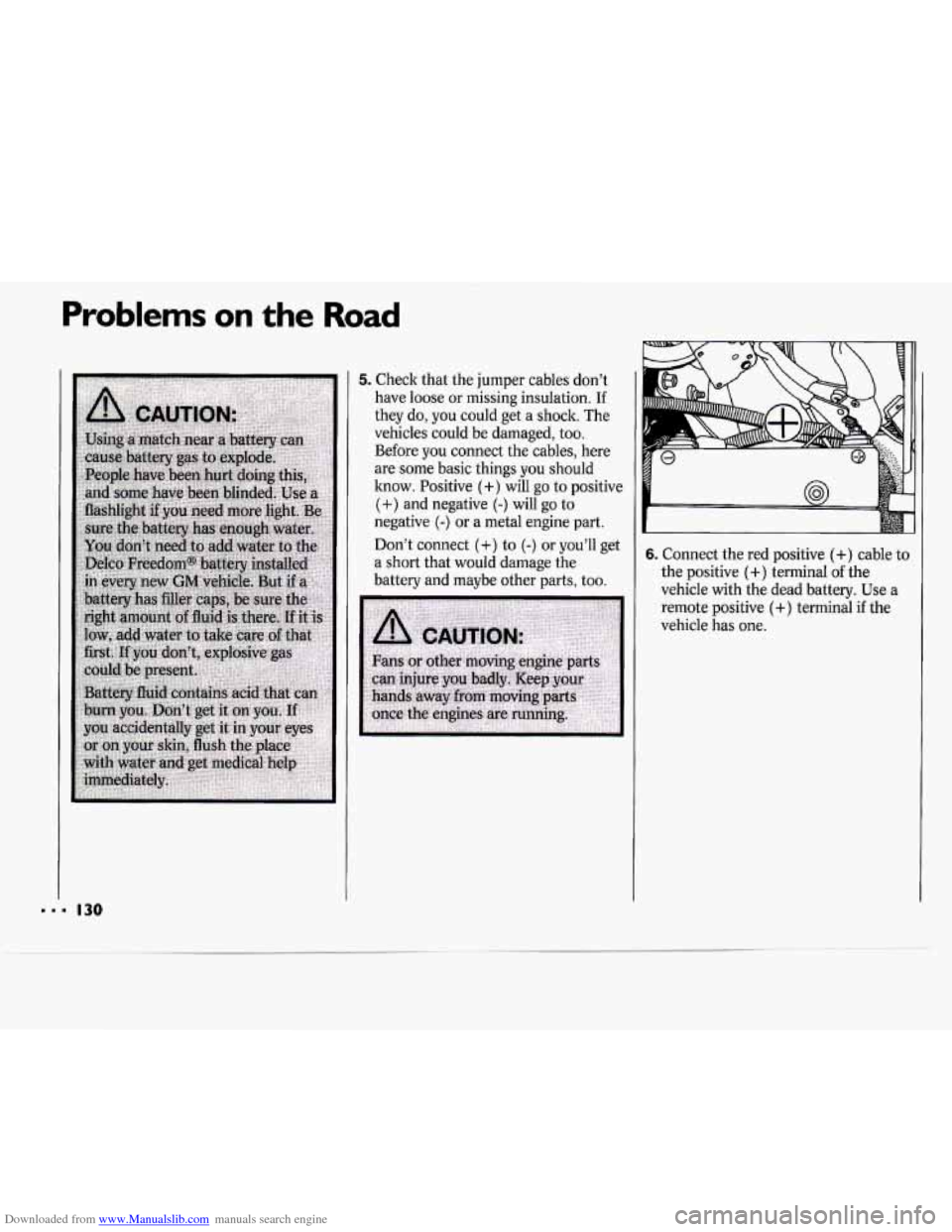
Downloaded from www.Manualslib.com manuals search engine Problems on the Road
5. Check that the jumper cables don’t
have loose or missing insulation. If
they do, you could get a shock. The
vehicles could be damaged, too.
Before you connect the cables, here
are some basic things you should
know. Positive
(+) will go to positive
(+) and negative (-) will go to
negative
(-) or a metal engine part.
Don’t connect
(+) to (-) or you’ll get
a short that would damage the
battery and maybe other parts, too. 6. Connect the red positive (+) cable to
the positive
(+) terminal of the
vehicle with the dead battery. Use a
remote positive
(+) terminal if the
vehicle has one.
Page 132 of 243
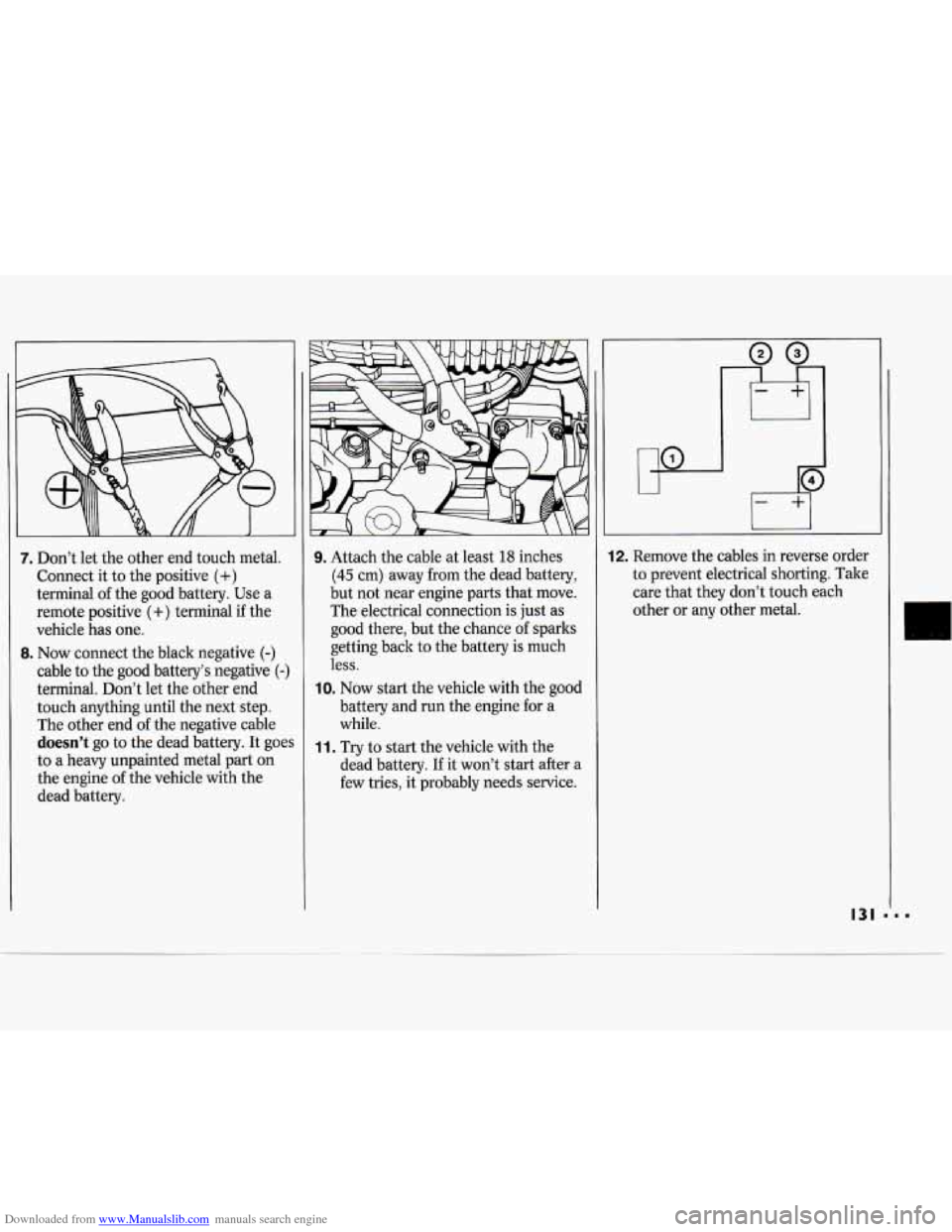
Downloaded from www.Manualslib.com manuals search engine 7. Don’t let the other end touch metal.
Connect it to the positive
(+)
terminal of the good battery. Use a
remote positive
(+) terminal if the
vehicle has one.
8. Now connect the black negative (-)
cable to the good battery’s negative (-)
terminal. Don’t let the other end
touch anything until the next step.
The other end of the negative cable
doesn’t go to the dead battery. It goer
to a heavy unpainted metal part on
the engine
of the vehicle with the
dead battery.
9. Attach the cable at least 18 inches
(45 cm) away from the dead battery,
but not near engine parts that move.
The electrical connection is just as
good there, but the chance of
sparks
getting back to the battery is much
less.
IO. Now start the vehicle with the good
battery and run the engine for a
while.
11. Try to start the vehicle with the
dead battery. If it won’t start after a
few tries, it probably needs service.
~~
12. Remove the cables in reverse order
to prevent electrical shorting. Take
care that they don’t touch each
other or any other metal.
Page 133 of 243
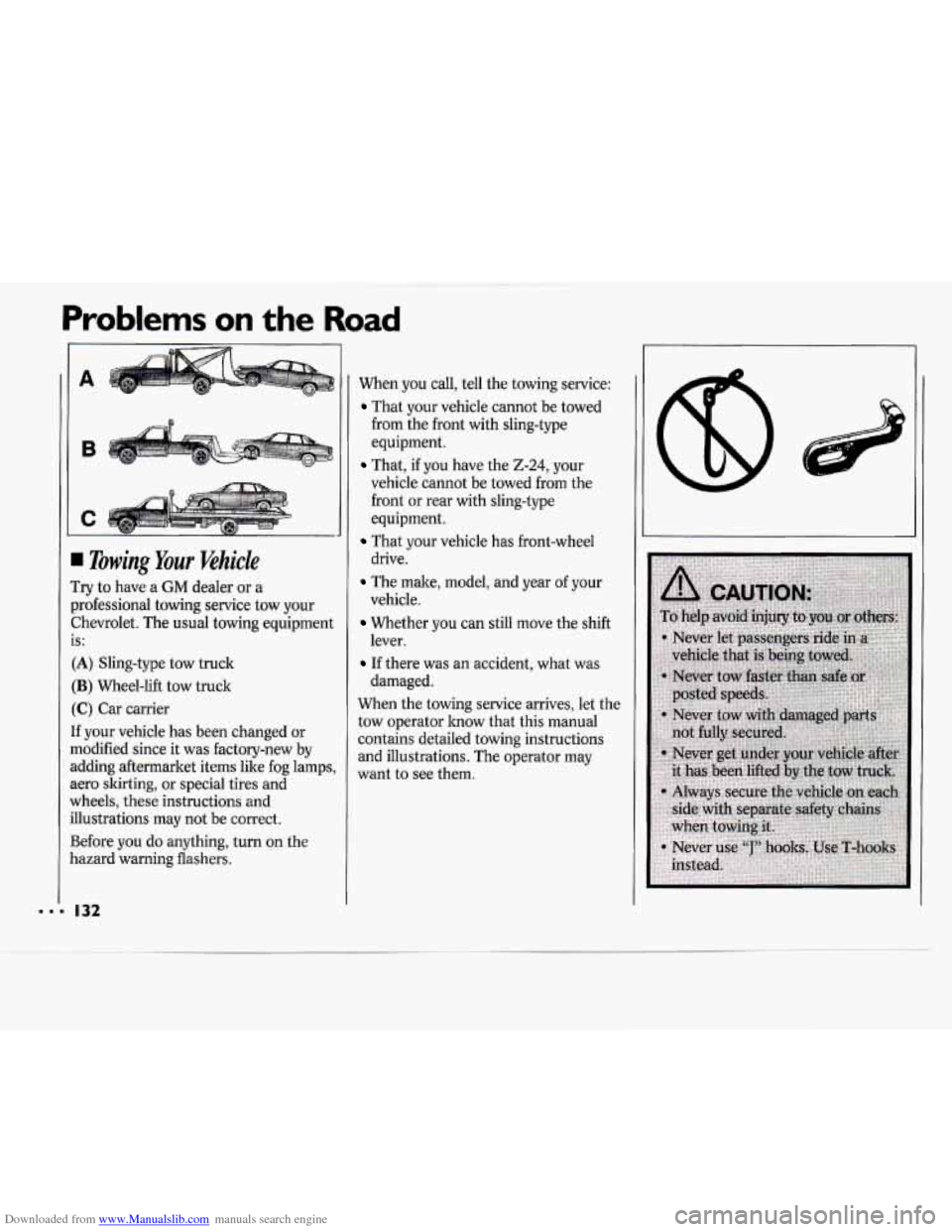
Downloaded from www.Manualslib.com manuals search engine Problems on the Road
-
A
B
I Towing Your Vehicle
Try to have a GM dealer or a
xofessional towing service tow your
Zhevrolet. The usual towing equipment
:A) Sling-type tow truck
:B) Wheel-lift tow truck
C) Car carrier
f your vehicle has been changed or
nodified since it was factory-new by
ldding aftermarket items like fog lamps,
iero skirting, or special tires and
uheels, these instructions and
llustrations may not be correct.
Before you do anything, turn on the
lazard warning flashers.
S:
When you call, tell the towing service:
That your vehicle cannot be towed
from the front with sling-type
equipment.
That, if you have the 2-24, your
vehicle cannot
be towed from the
front or rear with sling-type
equipment.
drive.
vehicle. lever.
damaged.
That your vehicle has front-wheel
The make, model, and year of your
Whether you can still move the shift
If there was an accident, what was
When the towing service arrives, let the
tow operator know that this manual
contains detailed towing instructions
and illustrations. The operator may
want to see them.
.I I32
Page 134 of 243
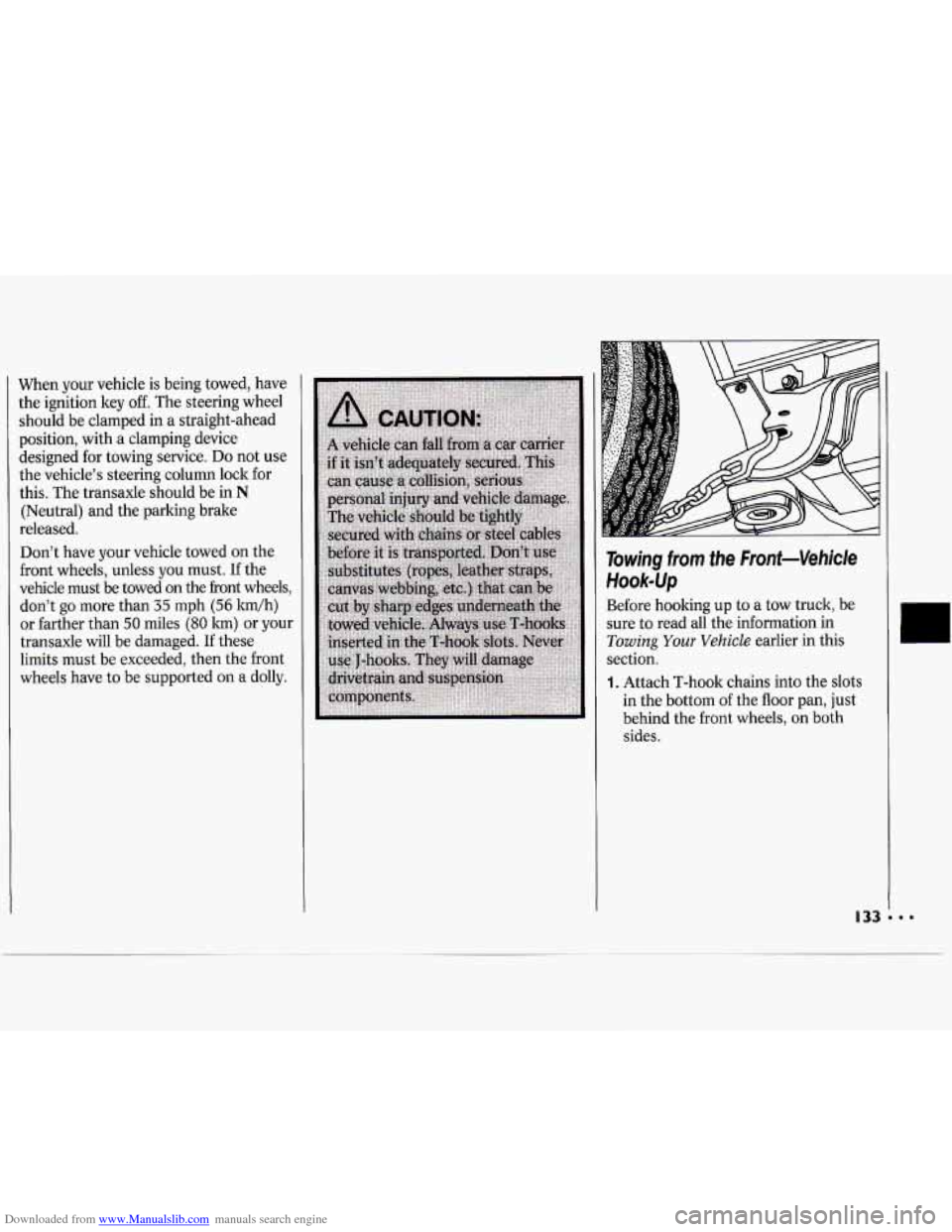
Downloaded from www.Manualslib.com manuals search engine When your vehicle is being towed, have
the ignition key
off. The steering wheel
should be clamped in a straight-ahead
position, with a clamping device
designed for towing service.
Do not use
the vehicle’s steering column lock for
this. The transaxle should be in
N
(Neutral) and the parking brake
released.
Don’t have your vehicle towed
on the
front wheels, unless you must. If the
vehicle must be towed
on the front wheels,
don’t
go more than 35 mph (56 kdh)
or farther than
50 miles (80 lun) or your
transaxle will be damaged.
If these
limits must be exceeded, then the front
wheels have to be supported on a dolly.
Towing from the Front-Vehicle
Hookup
Before hooking up to a tow truck, be
sure to read all the information in
Towing Your Vehicle earlier in this
section.
1. Attach T-hook chains into the slots
in the bottom
of the floor pan, just
behind the front wheels, on both
sides.
Page 135 of 243
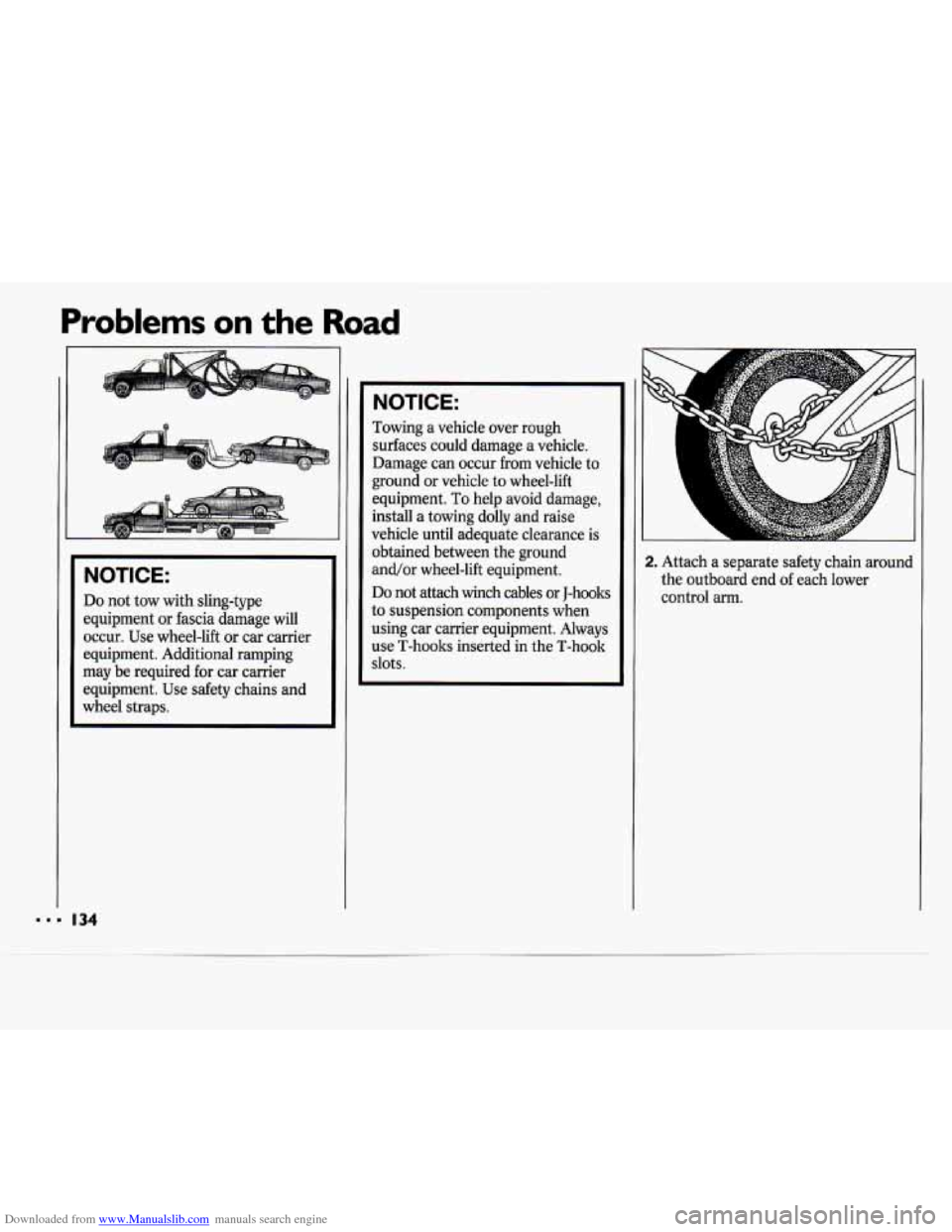
Downloaded from www.Manualslib.com manuals search engine Problems on the Road
NOTICE:
Do not tow with sling-type
equipment or fascia damage will
occur. Use wheel-lift or car carrier
equipment. Additional ramping
may be required for car carrier
equipment. Use safety chains and
wheel straps.
NOTICE:
Towing a vehicle over rough
surfaces could damage a vehicle.
Damage can occur from vehicle
to
ground or vehicle to wheel-lift
equipment.
To help avoid damage,
install a towing dolly and raise
vehicle until adequate clearance is
obtained between the ground
and/or wheel-lift equipment.
Do not attach winch cables or J-hooks
to suspension components when
using car carrier equipment. Always
use T-hooks inserted
in the T-hook
slots.
2. Attach a separate safety chain around
the outboard end
of each lower
control arm.
Page 136 of 243
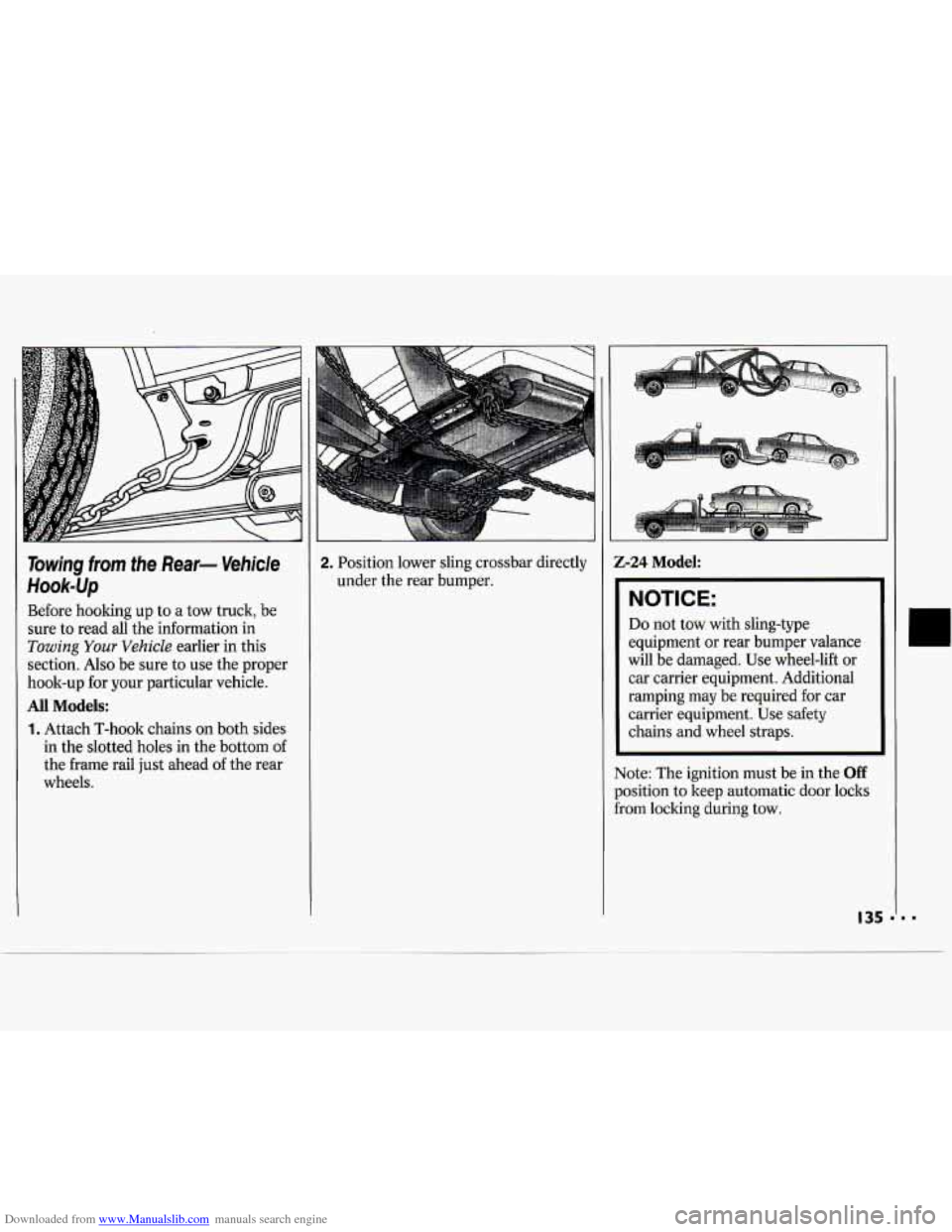
Downloaded from www.Manualslib.com manuals search engine Towing from the Rear- Vehicle
Hook-up
Before hooking up to a tow truck, be
sure to read all the information in
Towing Your Vehicle earlier in this
section.
Also be sure to use the proper
hook-up for your particular vehicle.
All Models:
1. Attach T-hook chains on both sides
in the slotted holes in the bottom
of
the frame rail just ahead of the rear
wheels.
2. Position lower sling crossbar directly
under the rear bumper.
I-
-24 Model:
NOTICE:
Do not tow with sling-type
equipment or rear bumper valance
will be damaged. Use wheel-lift
or
car carrier equipment. Additional
ramping may be required for car
carrier equipment. Use safety
chains and wheel straps.
~~
ote: The ignition must be in the Off
Isition to keep automatic door locks
3m locking during tow.
I
I
135 11 -
Page 137 of 243
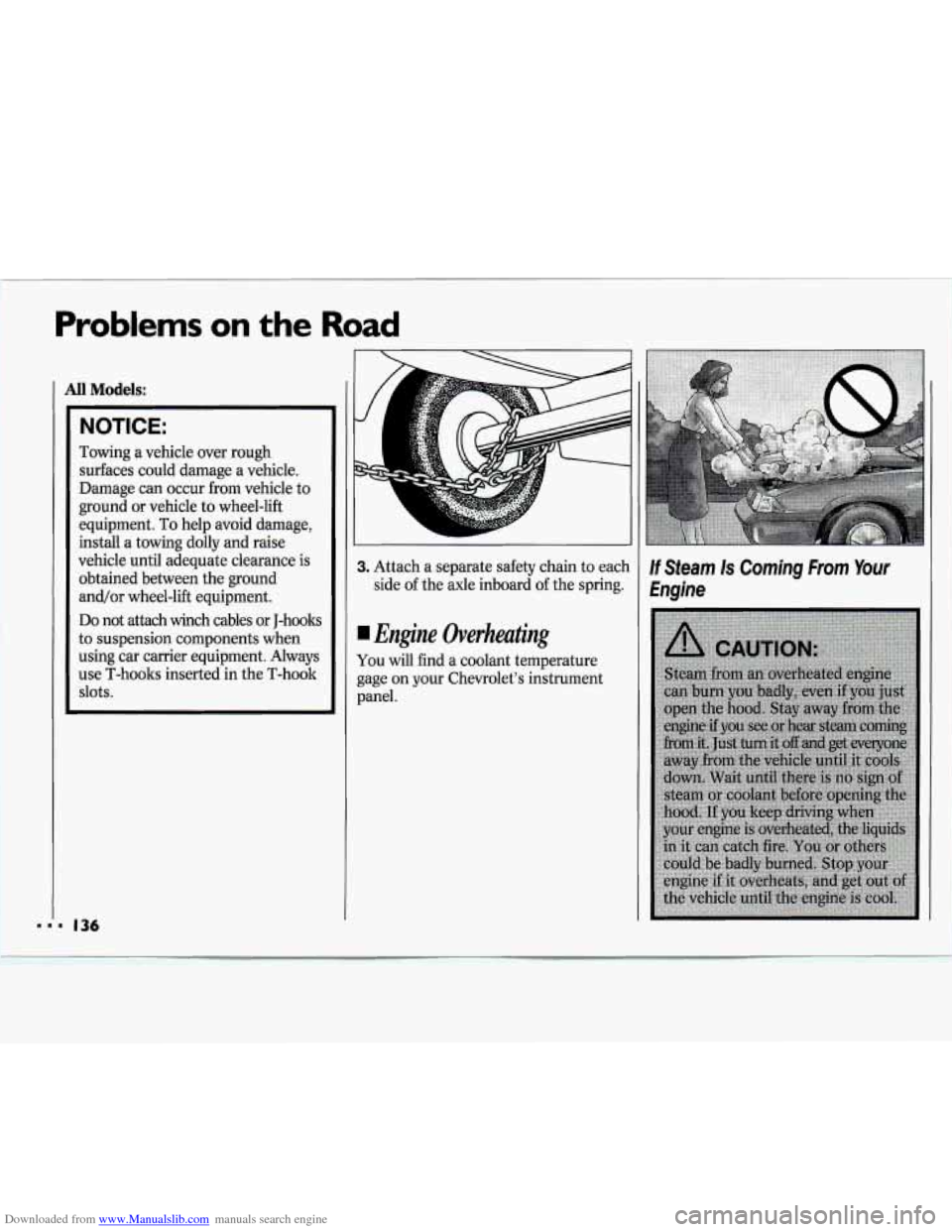
Downloaded from www.Manualslib.com manuals search engine Problems on the Road
All Models:
NOTICE:
Towing a vehicle over rough
surfaces could damage a vehicle.
Damage can occur from vehicle to
ground or vehicle to wheel-lift
equipment. To help avoid damage,
install a towing dolly and raise
vehicle until adequate clearance is
obtained between the ground
and/or wheel-lift equipment.
Do not attach winch cables or J-hooks
to suspension components when
using car carrier equipment. Always
use T-hooks inserted in the T-hook
slots.
r I I
3. Attach a separate safety chain to each
side of the axle inboard
of the spring.
Engine Overheating
You will find a coolant temperature
gage on your Chevrolet’s instrument
panel.
If Steam Is Coming From Your
Engine
Page 138 of 243
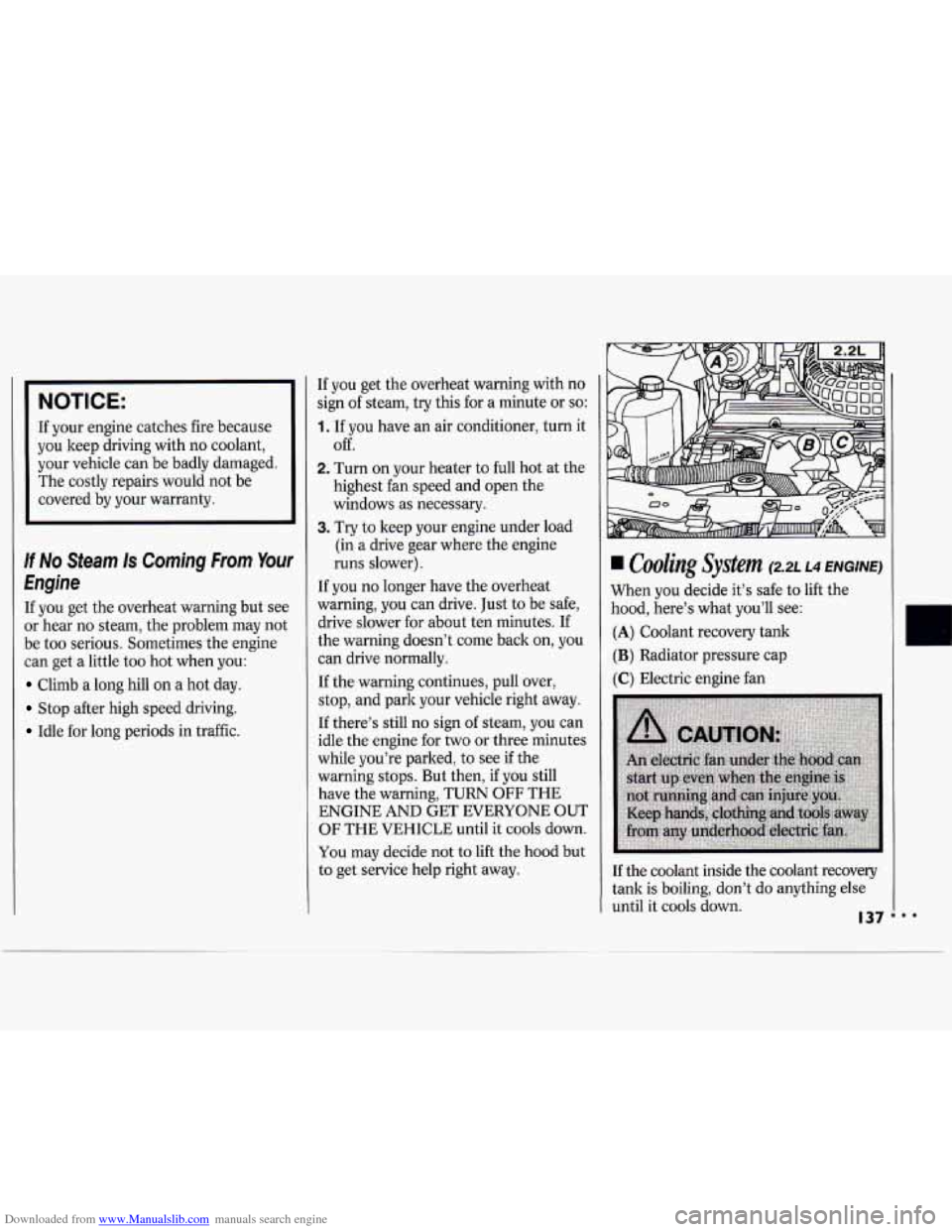
Downloaded from www.Manualslib.com manuals search engine I
NOTICE:
If your engine catches fire because
you keep driving with no coolant,
your vehicle can be badly damaged.
The costly repairs would not be
covered by your warranty.
If No Steam Is Coming From your
Engine
If you get the overheat warning but see
or hear no steam, the problem may not
be too serious. Sometimes the engine
can get a little too hot when you:
Climb a long hill on a hot day.
Stop after high speed driving.
Idle for long periods in traffic.
If you get the overheat warning with no
sign
of steam, try this for a minute or so:
1. If you have an air conditioner, turn it
2. Turn on your heater to full hot at the
Off.
highest fan speed and open the
windows as necessary.
3.
Try to keep your engine under load
(in
a drive gear where the engine
runs slower).
If you no longer have the overheat
warning, you can drive. Just
to be safe,
drive slower for about ten minutes.
If
the warning doesn’t come back on, you
can drive normally.
If the warning continues, pull over,
stop, and park your vehicle right away.
If there’s still no sign
of steam, you can
idle the engine for two or three minutes
while you’re parked, to see if the
warning stops. But then, if you still
have the warning, TURN
OFF THE
ENGINE AND
GET EVERYONE OUT
OF THE VEHICLE until it cools down.
You may decide not
to lift the hood but
to get service help right away.
hdirtg system (2.2L L4 ENGINE)
When you decide it’s safe to lift the
hood, here’s what you’ll see:
(A) Coolant recovery tank
(B) Radiator pressure cap
(C) Electric engine fan
If the coolant inside the coolant recovery
tank is boiling, don’t do anything else
until
it cools down. I37
Page 139 of 243
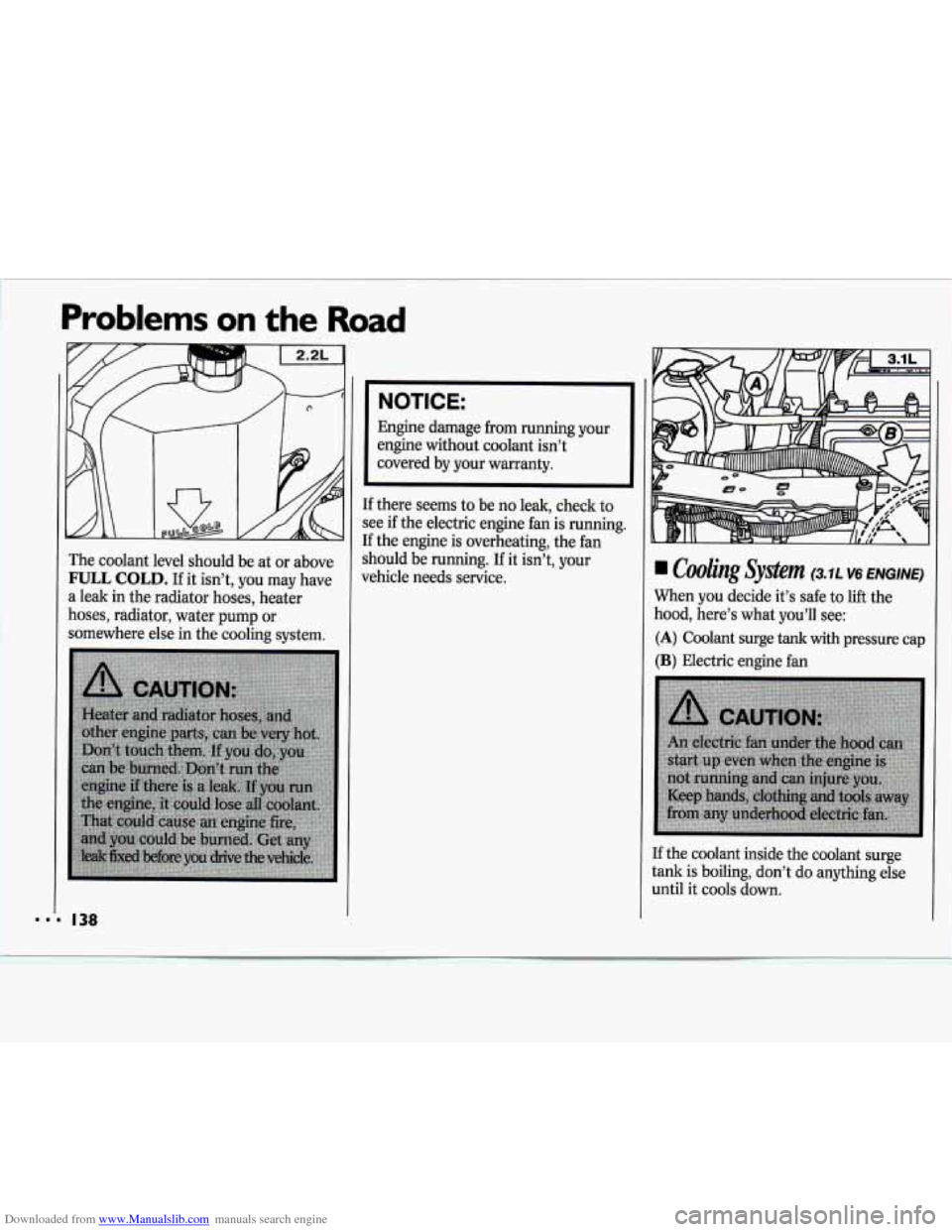
Downloaded from www.Manualslib.com manuals search engine Problems on the Road
The coolant level should be at or above
FULL COLD. If it isn’t, you may have
a leak in the radiator hoses, heater
hoses, radiator, water pump or
somewhere else in the cooling system.
I.. ’ 138
NOTICE:
Engine damage from running your
engine without coolant isn’t
covered by your warranty.
If there seems to be no leak, check to
see if the electric engine fan is running.
If the engine is overheating, the fan
should be running. If it isn’t, your
vehicle needs service.
coohg Sy&n (3.1 L V6 ENGINE)
When you decide it’s safe to lift the
hood, here’s what you’ll see:
(A) Coolant surge tank with pressure cap
(B) Electric engine fan
If the coolant inside the coolant surge
tank
is boiling, don’t do anything else
until it cools down.
Page 140 of 243
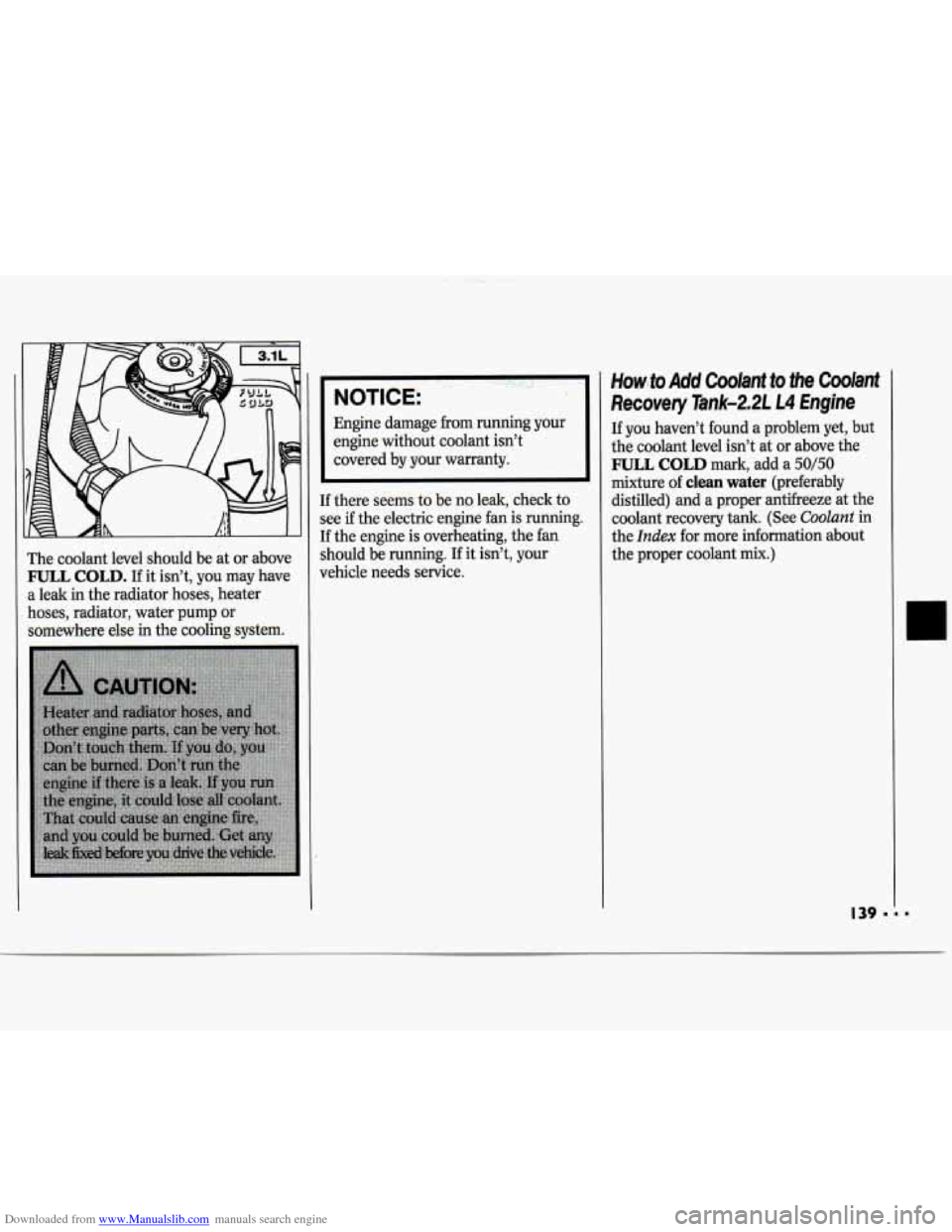
Downloaded from www.Manualslib.com manuals search engine The coolant level should be at or above
FULL COLD. If it isn’t, you may have
a leak in the radiator hoses, heater
hoses, radiator, water pump or
somewhere else in the cooling system.
I.
NOTICE:
’ I ._I
Engine damage from running your
engine without coolant isn’t
covered by your warranty.
If there seems to be no leak, check to
see
if the electric engine fan is running.
If the engine is overheating, the fan
should be running. If it isn’t, your
vehicle needs service.
Howlo Add Coolant to the Coolant
Recovery Tank-2.2L f.4 Engine
If you haven’t found a problem yet, but
the coolant level isn’t at or above the
FULL COLD mark, add a 50/50
mixture of clean water (preferably
distilled) and a proper antifreeze at the
coolant recovery tank. (See
Coolant in
the
Index for more information about
the proper coolant mix.)